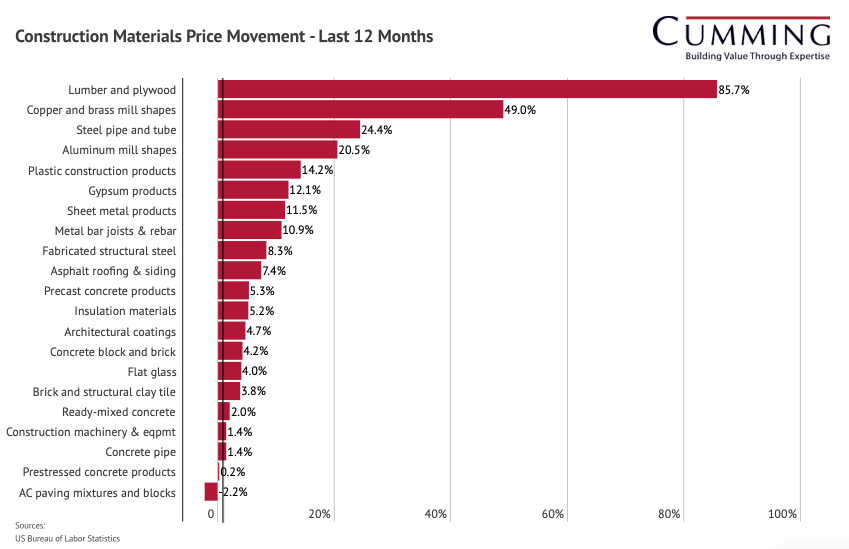Garret Murai | California Construction Law Blog
From lumber to used cars to pastrami sandwiches, prices are rising. This past month, at a town hall meeting in Cincinnati, Ohio, President Biden acknowledged that inflation was increasing, responding to a question from a restaurant owner about labor shortages, “I think your business and the tourist business is really going to be in a bind for a little while.”
Although construction companies typically don’t work in the same small margins that restaurants do, labor shortages and material price increases have nevertheless impacted the construction industry. According to a recent report by Cumming, the cost of construction materials from lumber to steel to gypsum have gone up over the last 12 months, in some cases nearly double:

For contractors entering into construction contracts and those performing work under existing contracts, the increasing cost of materials and shortage of labor creates challenges, some of which can be addressed through contractual provisions and the framework of those contracts. Here are a few things contractors might want to consider in today’s environment:
- Time and Material Contracts: Time and material contracts, whereby the owner pays the contractor for the contractor’s labor and material plus an agreed-upon fee, shifts the risks of price increases from the contractor to the owner. You can also include modified time and material provisions whereby the contractor will perform certain higher cost-risk work on a time and material basis, only.
- Building in Bigger Margins: Contractors can also build in bigger margins in their fixed fee and guaranteed maximum price contracts to account for price increases and/or include larger amounts for contingencies. While this will make a contractor’s bid less attractive to an owner who is soliciting several bids, sometimes it’s better to to lose out on a job, than to take a job and find that its costs exceed the anticipated profit.
- Cost Escalation Provisions: Contractors can also include a cost escalation provision in their contracts whereby the owner will pay for costs exceeding the contractor’s take-off calculations. These can be drafted in a variety of ways but typically provide that the owner will pay for increases in material costs which exceed a contractor’s take-off calculations or if they exceed the contractor’s take-off calculations by a certain percentage. Contractors wanting to incorporate cost escalation provisions in their contracts should be prepared to include their take-off as an exhibit to establish a baseline.
- Force Majeure Provisions: Force majeure provisions are another avenue for contractors to try to recoup the cost of escalating material prices, but are more difficult to enforce, as many force majeure provisions weren’t drafted with the specific intent of addressing rising material costs. Further, even when such provisions are broadly worded to include additional costs “not reasonably anticipated or caused by the contractor,” disputes can arise between the parties as to the intent and meaning of those provisions.
- Pre-Ordering Materials: Contractors can also lock in prices and help prevent delays by pre-ordering materials, particularly those involving long-lead times such as specialty equipment, but also more routine building materials they once may never have pre-ordered. Thought, of course, should also be given to the cost of storing and transporting those materials to the project site with appropriate provisions to account for those additional costs.
Ultimately, both owners and contractors want a project to come in within budget and within time, but when economic conditions outside the control of the parties make it difficult to do so, the parties should endeavor to employ a fair balancing of those risks, and appropriately drafted contractual provisions can be the means of doing so.
Be careful out there.
